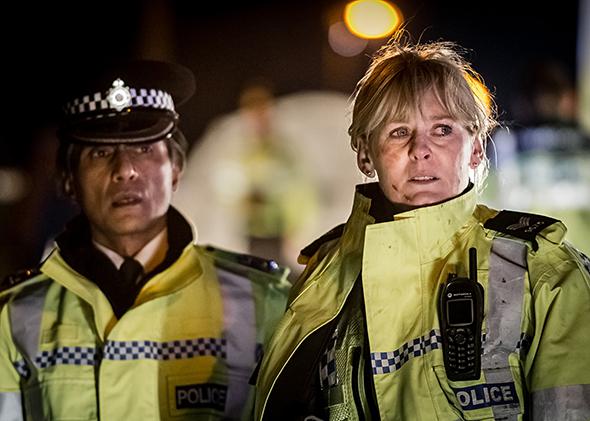Crime shows, by and large, can be split into two categories: the whodunits and the look-at-this-horrible-tragic-messes. In the first category, which contains everything from Law & Order and CSI to Twin Peaks and True Detective, the propulsive engine of the plot is: Who is the killer? Drawing on the genre thrills of the mystery, these series turn the audience into clue-hunting detectives. The best whodunits, of which True Detective and Twin Peaks are examples, leave us with more gut-punching takeaways than just the identity of a murderer, but those unsettling lessons come packaged in a compulsively watchable story structure.
The look-at-this-horrible-tragic-messes are series in which the killer or criminal is known—if not to the hero or heroine, at least to the audience—from the very start of the show. These include Fargo, The Fall, and Netflix’s new gritty and entrancing British import Happy Valley, a six-episode miniseries available in its entirety starting Wednesday. These series get a jolt of frisson out of the cat-and-mouse of it all: Will the hero be able to catch the bad guy, and in time? But they are, generally speaking, much more leisurely (and less highly rated) than whodunits. Knowing who the killer is, we, the audience, can stop clue-hunting and take a look around—typically at very bleak surroundings.
Happy Valley is set in one of the Yorkshire valleys in Northern England, and the title is meant extremely ironically. The series was written by Sally Wainwright and stars Sarah Lancashire as Catherine Cawood, a police sergeant with a complex past that she cheekily exposits in the first scene while dealing with one of the area’s many, many drug addicts. The proliferation of drugs—dispensed, in one memorable scene, from an ice cream truck—is not the subject of the show so much as its unyielding backdrop. Cawood explains that beat cops like herself are kept uninformed by higher-ups about where and how the drugs are coming into the city, but are still expected to deal with the day-to-day ramifications of endemic addiction and poverty. Her complaints are not, as they might be in an American series (or perhaps will be in the recently ordered second season of Happy Valley), signs that she is about to start cracking a vast drug conspiracy. It’s just another grim indication of the vast and unmanageable problems that she faces every day.
Cawood, additionally, has a very dark past of her own. Her teenage daughter was impregnated by a rapist and, after having the child, killed herself. Cawood decided to raise her grandson, now an elementary school-age boy named Ryan with temper problems, even though doing so cost her both her marriage and her relationship with her own son. The young man who raped Cawood’s daughter, Tommy Lee Royce (James Norton, another very handsome sociopath), was never charged or convicted for it; he went to prison on drug charges instead. As the series begins, he’s just been paroled. Cawood immediately becomes fixated on keeping track of him, an obsession that begins to pay dividends as Royce, barely out of prison, gets caught up in the series’ major storyline, a kidnapping gone very, very wrong.
If this all sounds much too bleak, well, I’m not sure there is one shot in full sunshine in the entire show. But Lancashire’s Cawood is not a dreary character: She’s funny, caring, flawed, full of moxie, and a little unhinged. She is the kind of woman who feels compelled to help in situations where helping may be both pushy and dangerous. She is self-aware and acerbic even as she is occasionally out of control. After Royce’s release, Cawood’s sister, a recovering heroin addict (Downton Abbey’s Siobhan Finneran, aka O’Brien, but totally unrecognizable), cautions Cawood that she doesn’t seem to be dealing with the situation rationally. Cawood scoffs. How could she possibly be rational? She’s just trying to be “effective.”
Over the course of the case, she puts herself into physical danger again and again. And she never got the memo about the superior strength of men: Cawood is the sort of woman who will try and lift a strapping young man up by his lapel and takes pride in the occasional black eye. But as the show goes on, the violence mounts, and it can be remarkably bracing—in a way distinct from many American shows: There are almost no guns. The police officers appear to carry none. The criminals don’t either. The violence gets personal and exacting and it lasts a long time. There are no swift, distancing bullets.
Happy Valley, like Broadchurch and The Fall (also from the U.K.) as well as The Killing and The Bridge (two Scandinavian shows)—not to mention the mother of them all, Prime Suspect—suggests just how much story can still be found in the life of a middle-aged, female law enforcement official, a less played-out counterpart to the grizzled, seen-it-all-detective. Motherhood is, unshowily, one of the recurring motifs of Happy Valley. Tommy Royce, whose drug-addicted mother we see a number of times, is the product of absent and terrible parenting. And Cawood is raising a small boy whom she worries may have some of his father in him—how else to explain all those tantrums? Her decision to keep caring for Ryan is not unlike her decision to keep doing her job every day, a knowing act of vulnerability. If everything’s already a horrible-tragic-mess, she can only improve the situation.
